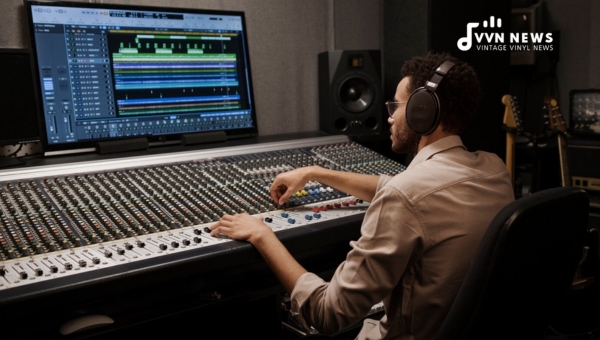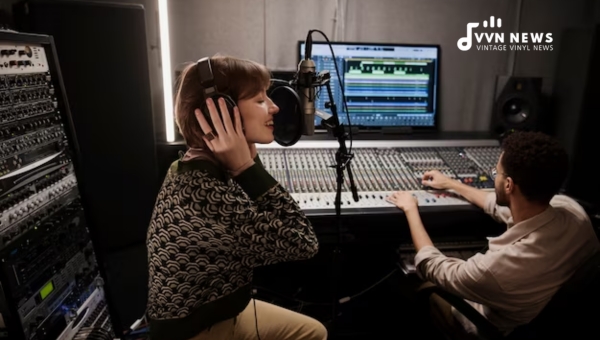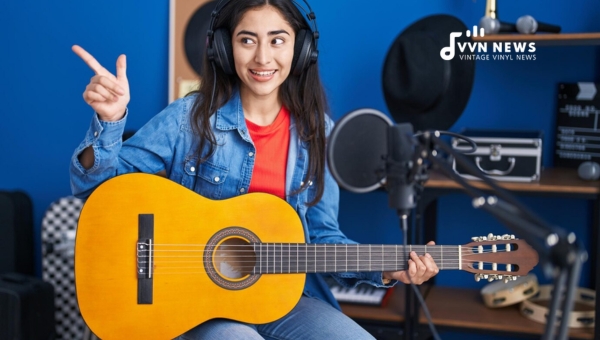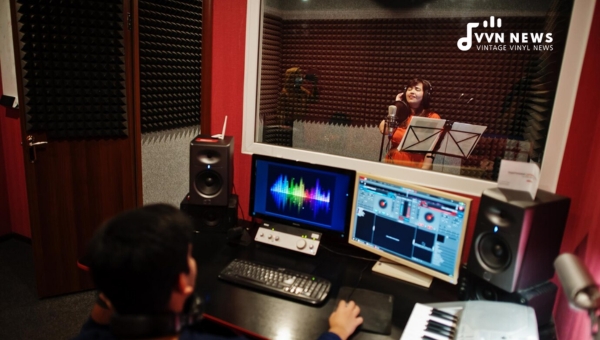Music has always been a soothing balm for the soul, an outlet for creativity, and a chance to share stories and emotions.
It’s also increasingly become a channel through which many independent artists reach millions of listeners globally.
For this reason, understanding how to set up a home recording studio has never been more crucial. For those longing musicians out there who harbor dreams of laying down their tracks or podcast enthusiasts eager to begin their journey of sharing insights or stories, help is at hand.
My mission in writing this blog post is simple – providing you with a comprehensive, easy-to-understand guide on setting up your home recording studio.
This guide will navigate the murky waters of technical selection and arrangement for you in a professional yet understandable way. So, buckle up as we embark on this new musical journey together.
Fundamentals of Home Studio Set up
A home studio set up consists of various components, all tailored towards producing high-quality audio. Below are the basic elements you’d need to get started.
Room Selection: Choose a quiet, isolated, and sizeable room to fit your equipment and leave enough space for sound movements. Your garage or basement could work perfectly!
Equipment: This includes recording, monitoring, and processing gear that are crucial for every home studio: microphones, audio interfaces, headphones or monitors/speakers, and relevant software (DAWs – Digital Audio Workstations).
Acoustic Treatment: This ensures the sound within the room is ideal for recording. Use diffusers, bass traps, and porous materials to manage interference in sound wave movements.
Lastly, ensure your room is well-ventilated and well-lit to keep yourself comfortable during long recording sessions.
Signal Flow Diagram: A Detailed Guide

Just like a blueprint for constructing a building, the signal flow diagram serves as the map directing audio signals from their source to their final destination.
Understanding this pathway of sound can dramatically simplify the process of setting up your home studio and troubleshooting issues should the need arise.
Understanding Signal Flow Diagram
Before delving into a full-fledged signal flow diagram, let’s break it down into its most basic form.
It begins with your primary sound source (often an instrument or vocal mic), flows through intermediate pathways (mixing consoles and cables), and ends at your destination (speakers or headphones). In simplified terms:
Vocals/Instruments > Microphone > Preamplifier > Equalizer > Compressor > Interface/Converters > Computer > Monitors
We’re now going to walk through each of these stages in detail.
Vocals and Instruments
Every sound recording commences with a source. This is where the Vocals and Instruments come into play. Whether it’s your voice, a guitar, a keyboard, or any other instrument, this represents the start of our signal flow.
Microphone
The Microphone picks up these acoustic sound waves and transforms them into electronic signals. This is known as transduction.
Preamplifier (Preamp)
The electronic signals from the microphone are relatively feeble and need boosting to match the other audio levels in your studio — that’s where your Preamplifier comes into play.
Equalizer
Next in line is the Equalizer. Its job is to adjust frequency responses to boost or cut specific bands of frequencies, shaping the sound that will eventually reach your listeners.
Also Read: Should I Upgrade My Mastering Equalizer? [Things To Consider]
Compressor
The Compressor’s function is all about controlling dynamics; it reduces the difference between loud and soft parts of a track, making everything more consistent volume-wise.
Interface / Converters
Your analog audio now enters an Interface / Converter, which converts analog signals into digital ones that your computer can process.
Computer
Your computer, loaded with a Digital Audio Workstation (DAW), receives these digital signals for recording, editing, mixing, and mastering before you broadcast or share it out to the world.
Monitors
Finally, we have Monitors. These are not regular consumer speakers but precision devices that provide an accurate reproduction of your final output without coloring or distorting the sound.
That’s your essential guide to understanding signal flow diagrams. Now, you should have a clearer view of how each component interacts with the others within your home recording studio set up.
Embrace this adventure because every step draws you closer to achieving that perfect sound in your very own home studio.
How Sound Travels in a Studio
Essentially, sound travels in a studio just as it does elsewhere; it moves as waves emanating from a source – i.e., an instrument or voice – towards a pickup, often a microphone.
First, sound waves encounter acoustic treatment in the room. They then get manipulated before making contact with the microphone.
This microphone converts these acoustic waves into electrical signals, which are then transmitted to an audio interface.
Once in the interface, they convert again into digital data for the computer.
Within the Digital Audio Workstation (DAW), they’re processed and edited before finally being output through monitors (speakers).
The journey can be summarized as follows:
- Sound produced.
- Sound picked up by the microphone.
- Translated into an electrical signal.
- Signal converted to digital data by the audio interface.
- Data processed and edited in DAW.
- The final output is directed through monitors or headphones.
Hence, understanding this sound travel process helps with gear set up synchronization, making sure every piece of your home studio is part of one smooth workflow.
Basic Equipment for Home Recording Studios

When setting up a home recording studio, there exists a handful of essential gear needed to get started.
Microphones
A good quality microphone is indispensable for your set up. Choose based on the nature of the recording; condenser microphones work great for vocals and high frequencies, while dynamic microphones are suited for instruments and low frequencies.
Audio Interface
An audio interface connects your microphone and other equipment to your computer. They imbue quality into your sound and provide phantom power (required by condenser mics).
Headphones/Monitors
While basic headphones are sufficient, studio-grade monitors or speakers offer you an accurate representation of how your recording truly sounds.
Digital Audio Workstations (DAWs)
DAWs are software programs useful in editing, mixing, and mastering audio tracks; examples include ProTools Ableton Live, amongst others.
MIDI Keyboard
For the music producers out there, a MIDI keyboard or controller is key to your set up. It simplifies inputting instrument sounds into your DAW.
Cables
You will need different types of cables, such as XLR and 1/4-inch TRS, to connect your equipment.
Setting up a home recording studio might seem like climbing Everest. Still, once you understand the basic components, it becomes a delightful journey that allows you to express your creative spirit in unparalleled ways.
Tips On How To Set Up A Home Recording Studio
Aspiring to take your home studio to another level is natural after mastering the basics. Here are some professional tips that can help upscale your home studio set up.
Invest in High-quality Gear
Starting with affordable, basic, and mid-range gear is great. But if you’re planning to turn professional, consider investing in top-notch microphones, preamps, interfaces and monitors. Remember; quality shouldn’t come at the expense of breaking banks. Purchase equipment within your financial reach.
Sound Isolation
For top-tier recording, your room needs advanced isolation from outside noises (caused by people or nature). Double glazing windows or adding mass-loaded vinyl can block sound effectively. Also consider getting doors seals for any small openings letting noise in.
Room Shape
Rooms with parallel walls create standing waves that might affect recording quality. A rectangular room with non-parallel walls makes an ideal space.
Professional Wiring
A solid cable management system saves you time by preventing unnecessary troubleshooting of unforeseen technical issues down the line.
Every step towards a professional-quality studio marks a great leap toward mastering your sound and music production skills.
Also Read: Home Studio Essentials [Equip Your Space Like A Pro]
Choosing the Right Cables for Your Recording Projects

When setting up a home recording studio, the topic of cables might seem trivial in comparison to microphones, monitors, or interfaces. Selecting the right lines can make a significant impact on the strength and quality of your audio signals. So how does one decide between Analog versus Digital or Balanced versus Unbalanced?
Analog versus Digital Cables
Analog cables transmit audio signals through continuous electrical currents, which can be susceptible to interference and noise. Examples of analog cables would be XLR, TRS, and RCA.
On the other hand, Digital cables deliver audio information in discrete binary bits (ones and zeros), ensuring accuracy without interference. They typically provide cleaner sound quality than their analog counterparts, as there’s no degradation in signal over long distances. Popular digital cables include HDMI, USB, FireWire or Thunderbolt.
Balanced versus Unbalanced Cables
Another crucial decision lies between balanced and unbalanced cables. Unbalanced cables have two conductor wires – one carrying the signal and the other acting as a ground shield around it.
They’re more prone to picking up electronic noise from light fixtures or power lines as this static becomes a part of the audio signal itself.
Meanwhile, Balanced cables boast three conductor wires- positive (hot), negative (cold) and ground (earth).
The balanced audio design cancels out any noise picked up along the cable length giving an incredibly clean signal.
Your choice will depend on your gear’s compatibility and needs.
However, correctly managing your cabling leads to optimal sound performance when recording or mixing down music tracks in your studio.
Does Every Studio Have the Same Signal Flow?
The signal flow in a recording studio refers to the path that audio signals take from the input source to the output destination.
Although there’s generally a typical order of operations, no two studios have the same signal flow.
Signal flow usually starts at the source of sound (e.g., vocal cords or instrument), continues through a microphone, into an audio interface, and then onto a digital audio workstation (DAW).
This sequence can vary based on factors like the studio’s physical layout, equipment used, and specific needs of a project.
Understanding your studio’s unique signal flow is key for efficient troubleshooting and effective control over sound quality.
While setting up your home studio, it is imperative to note that each piece of equipment should have its place in this auditory journey, depending upon its functionality.
This knowledge will help you troubleshoot more efficiently and manipulate your equipment effectively to get the best sound output for any given project.
So, though various studios may have different signal flows based on their structure or requirements, there remains a standard process that can be used as a guide while setting up your home recording studio.
Also Read: 25 Best Condenser Microphones For Pro & Home Studios In 2025
FAQs About Home Recording Studio
How do I set up a recording studio at home?
To set up a recording studio at home, you need to identify a suitable room, install soundproofing, arrange for necessary equipment like microphones, headphones, audio interface and install recording software.
What do you need for a simple home recording studio?
For a simple home recording studio, you primarily need an audio interface, microphone, headphones, studio monitors, and recording software. You may also require soundproofing material based on the acoustics of your room.
What is the best room for a home recording studio?
The best room for a home recording studio is one that is relatively quiet with less external noise. It should be spacious enough to accommodate the equipment and ideally have high ceilings for better acoustics.
How do I make my home recording sound professional?
To make your home recording sound professional, use high-quality equipment like good microphones and headphones. Also important is editing by using recording software that allows you to manipulate the audio recorded, giving it a polished look.
Which software is used to record sound?
A number of software can be used to record sound, such as Audacity, GarageBand, Pro Tools, Logic Pro X, and FL Studio. These software offer different features catering to various needs of audio production.
Conclusion
Setting up a home recording studio might first seem like a daunting endeavor.
But with a meticulous selection of equipment, the right room, and good acoustic treatment, it will quickly morph into an exciting passion project.
Whether your goal is skyrocketing your music career or starting that captivating podcast, a home studio sets you on the path to realizing these dreams.
It’s not often an overnight task. Enjoy the process as it molds you into an independent audio creative.








